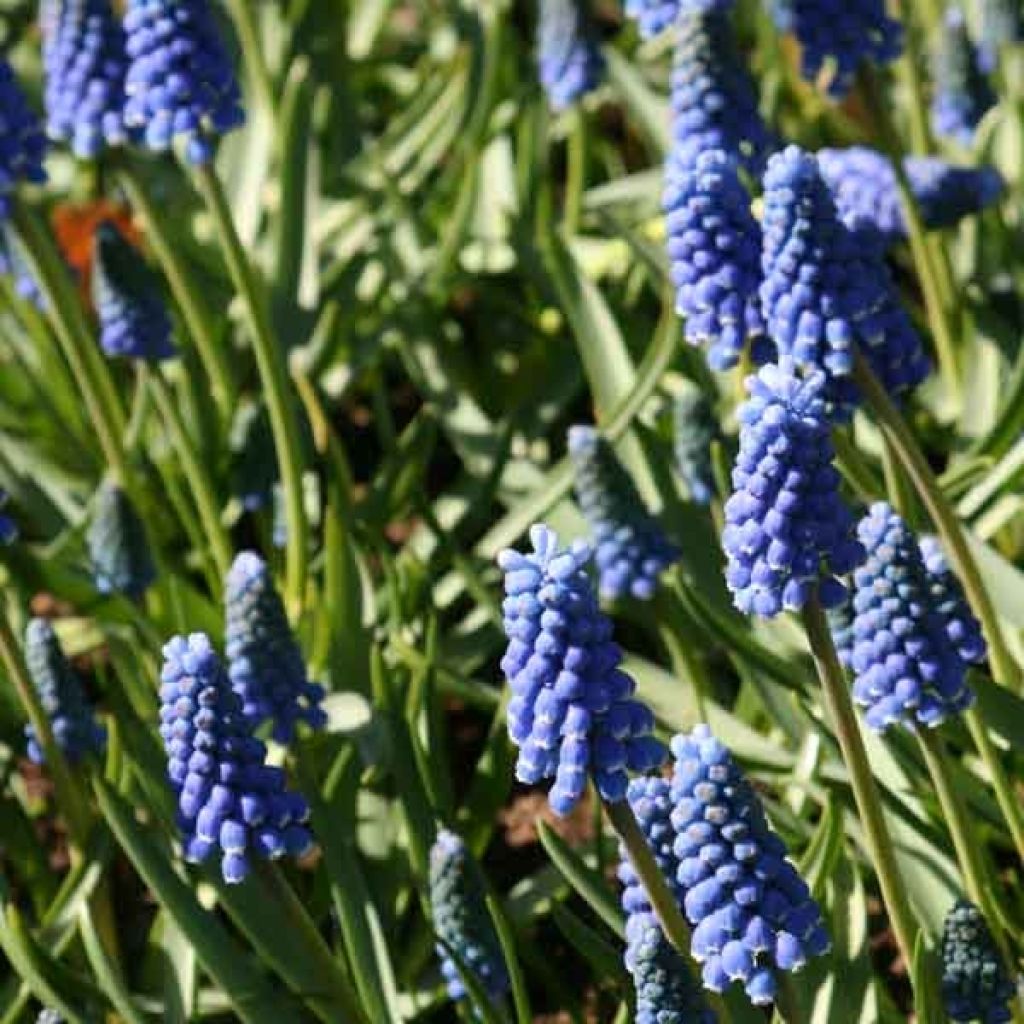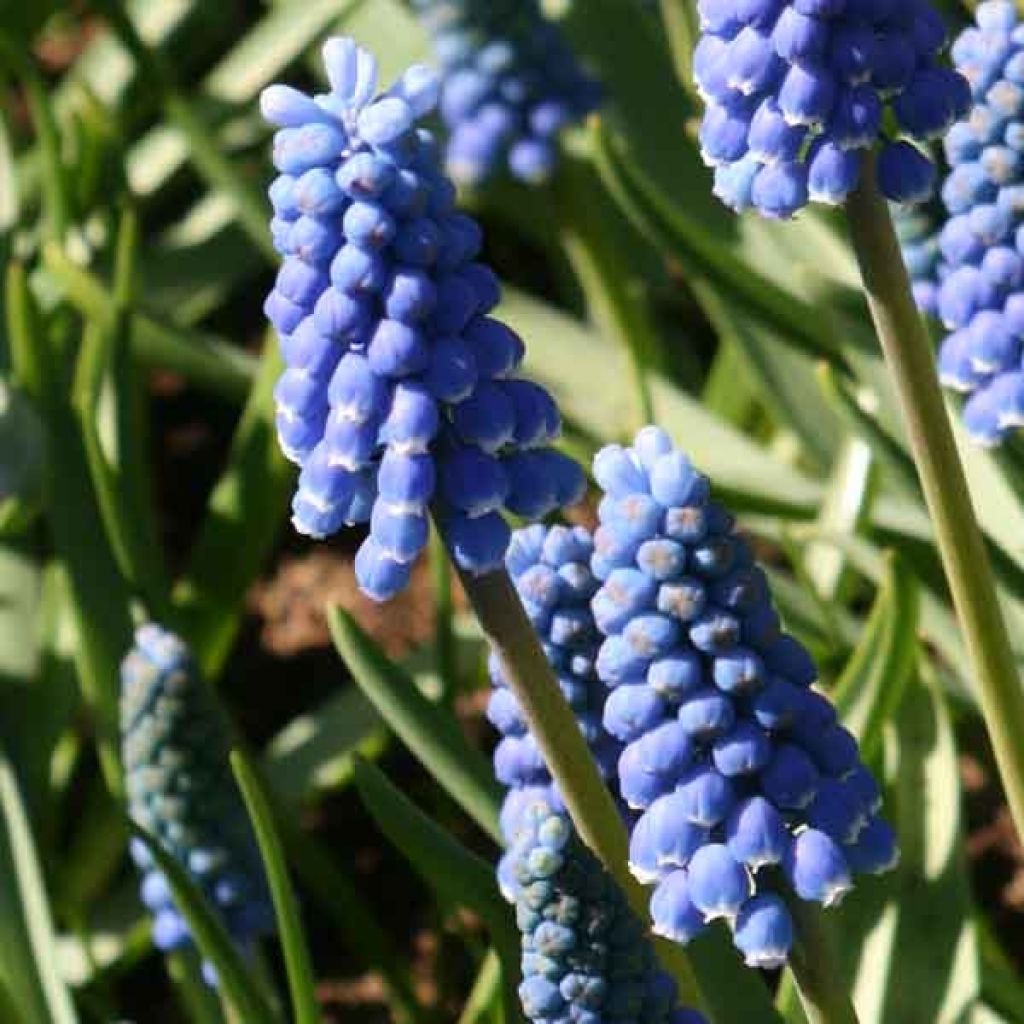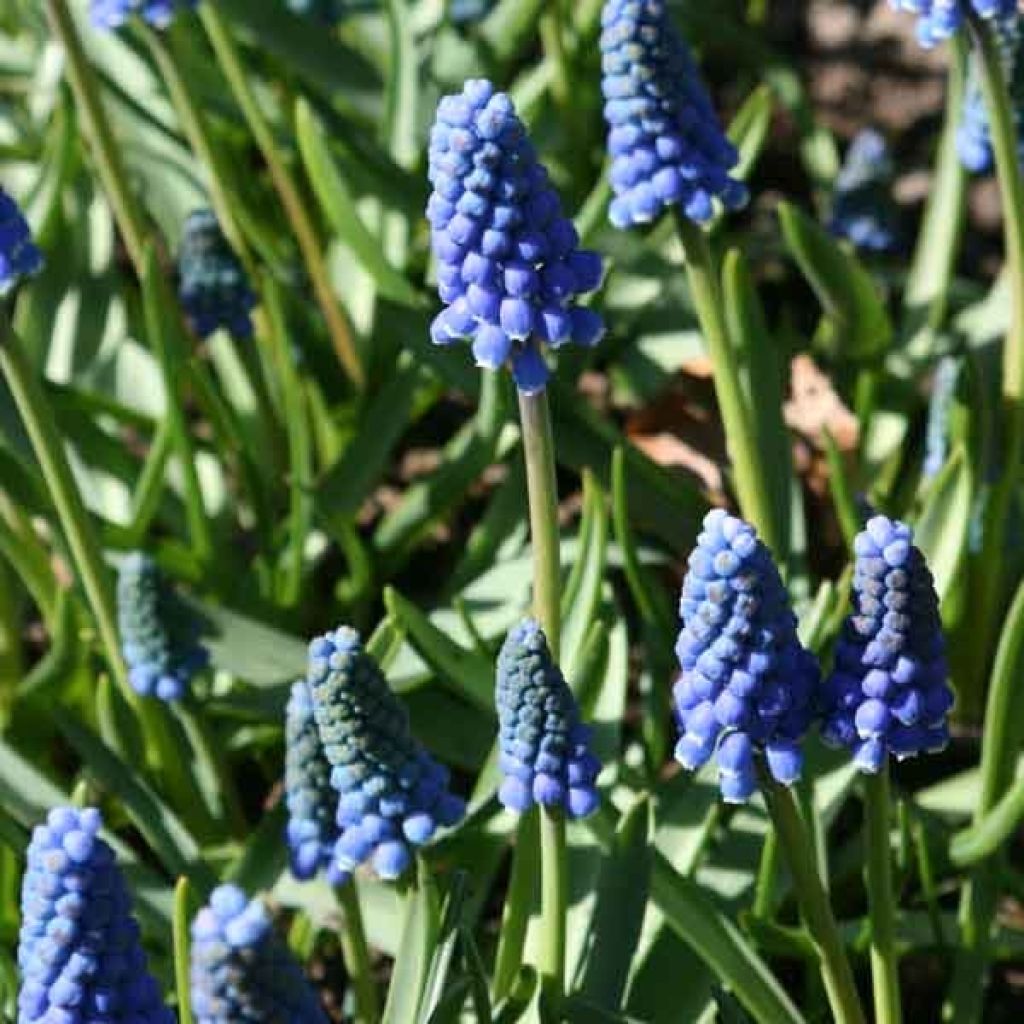

Muscari Aucherii Blue Magic 7+


Muscari Aucherii Blue Magic 7+


Muscari Aucherii Blue Magic 7+
Muscari aucheri Blue Magic
Muscari aucheri Blue Magic
Grape Hyacinth
This plant carries a 6 months recovery warranty
More information
We guarantee the quality of our plants for a full growing cycle, and will replace at our expense any plant that fails to recover under normal climatic and planting conditions.
From €5.90 for pickup delivery and €6.90 for home delivery
Express home delivery from €8.90.

Does this plant fit my garden?
Set up your Plantfit profile →
Description
Muscari aucheri Blue Magic is a rare horticultural variety with abundant flowering in the form of small, bright blue clusters, which appear in April-May on a carpet of bright green leaves reminiscent of snowdrops. Derived from the species often cultivated in gardens, this vigorous little bulb is perfectly hardy and easily naturalises in the garden. It thrives in both pots and borders, in well-drained soil, in full sun or partial shade. Just like hyacinths, it can be easily forced from autumn to enjoy its flowering at home, in the heart of winter.
Muscari aucheri is a bulbous plant from the hyacinth family, native to alpine meadows in the mountains of Turkey. Medium-sized for a muscari, the 'Blue Magic' variety sometimes reaches 25 cm (10in) high and 15 cm (6in) wide. Its vegetative cycle begins in September-October, when its foliage appears (often 3 leaves are observed). Its fairly wide, ribbon-like leaves are greenish-grey on top, stay neat after flowering and persist throughout the winter. A single flower stalk emerges in spring, April-May depending on the climate and weather. The inflorescence is a cluster of flowers 2 to 6 cm (1 to 2in) long and about 1.5 cm (1in) wide, exuding a heavy and intoxicating fragrance. The small urn-shaped flowers measure only 5 to 6 mm (0in) long and are tightly packed together, forming a narrow and dense cone. The pale green buds open into bright blue flowers, without any trace of violet. This bulb naturalises slowly but surely in light soil, without ever becoming invasive.
Plant Muscari 'Blue Magic' en masse, in groups of about ten bulbs, in a flower carpet or along a path for good decorative effect, or randomly naturalise them in a meadow, and at the base of bushes. Its true blue flowers will beautifully highlight all the other spring bulbs, narcissus, early hyacinths, ipheions, anemone blanda, iris reticulata... You can also plant it with other muscari (M. 'Ocean Magic, 'White Magic, M. latifolium, M. armeniacum) to further expand the colour palette. They blend well with daffodils and snowdrops. Pink or white tulips are also good companions for their graceful flowering.
Report an error about the product description
Plant habit
Flowering
Foliage
Botanical data
Muscari
aucheri
Blue Magic
Hyacinthaceae
Grape Hyacinth
Cultivar or hybrid
Planting and care
Plant your muscari as soon as possible (in September), in well-drained soil to ensure hardiness. Loosen the soil deeply. Drainage can be improved by adding fine gravel, either as a layer under the bulbs or mixed with the soil if necessary. Plant the bulbs 10 cm (4in) deep (Bulbs should be covered with about twice their height of soil) and 8 cm (3in) apart, or group them in clusters (avoiding bulb-to-bulb contact). This Muscari tolerates dense shade under deciduous trees, or partial shade, but also likes a sunny exposure that is not scorching. It prefers fertile soils, where it will thrive, but can also tolerate poor soil, where it will be smaller. Once in place, the bulbs will flower for many years if the soil is well-drained. After 2 years, you can divide the clumps and replant the bulbils from the originally planted bulbs. This will expand the covered area and promote flower vigour. If you grow them in pots, water generously in winter and autumn, then less in summer and completely stop watering during the dormancy period.
Planting period
Intended location
Care
-
, onOrder confirmed
Reply from on Promesse de fleurs
Haven't found what you were looking for?
Hardiness is the lowest winter temperature a plant can endure without suffering serious damage or even dying. However, hardiness is affected by location (a sheltered area, such as a patio), protection (winter cover) and soil type (hardiness is improved by well-drained soil).

Photo Sharing Terms & Conditions
In order to encourage gardeners to interact and share their experiences, Promesse de fleurs offers various media enabling content to be uploaded onto its Site - in particular via the ‘Photo sharing’ module.
The User agrees to refrain from:
- Posting any content that is illegal, prejudicial, insulting, racist, inciteful to hatred, revisionist, contrary to public decency, that infringes on privacy or on the privacy rights of third parties, in particular the publicity rights of persons and goods, intellectual property rights, or the right to privacy.
- Submitting content on behalf of a third party;
- Impersonate the identity of a third party and/or publish any personal information about a third party;
In general, the User undertakes to refrain from any unethical behaviour.
All Content (in particular text, comments, files, images, photos, videos, creative works, etc.), which may be subject to property or intellectual property rights, image or other private rights, shall remain the property of the User, subject to the limited rights granted by the terms of the licence granted by Promesse de fleurs as stated below. Users are at liberty to publish or not to publish such Content on the Site, notably via the ‘Photo Sharing’ facility, and accept that this Content shall be made public and freely accessible, notably on the Internet.
Users further acknowledge, undertake to have ,and guarantee that they hold all necessary rights and permissions to publish such material on the Site, in particular with regard to the legislation in force pertaining to any privacy, property, intellectual property, image, or contractual rights, or rights of any other nature. By publishing such Content on the Site, Users acknowledge accepting full liability as publishers of the Content within the meaning of the law, and grant Promesse de fleurs, free of charge, an inclusive, worldwide licence for the said Content for the entire duration of its publication, including all reproduction, representation, up/downloading, displaying, performing, transmission, and storage rights.
Users also grant permission for their name to be linked to the Content and accept that this link may not always be made available.
By engaging in posting material, Users consent to their Content becoming automatically accessible on the Internet, in particular on other sites and/or blogs and/or web pages of the Promesse de fleurs site, including in particular social pages and the Promesse de fleurs catalogue.
Users may secure the removal of entrusted content free of charge by issuing a simple request via our contact form.
The flowering period indicated on our website applies to countries and regions located in USDA zone 8 (France, the United Kingdom, Ireland, the Netherlands, etc.)
It will vary according to where you live:
- In zones 9 to 10 (Italy, Spain, Greece, etc.), flowering will occur about 2 to 4 weeks earlier.
- In zones 6 to 7 (Germany, Poland, Slovenia, and lower mountainous regions), flowering will be delayed by 2 to 3 weeks.
- In zone 5 (Central Europe, Scandinavia), blooming will be delayed by 3 to 5 weeks.
In temperate climates, pruning of spring-flowering shrubs (forsythia, spireas, etc.) should be done just after flowering.
Pruning of summer-flowering shrubs (Indian Lilac, Perovskia, etc.) can be done in winter or spring.
In cold regions as well as with frost-sensitive plants, avoid pruning too early when severe frosts may still occur.
The planting period indicated on our website applies to countries and regions located in USDA zone 8 (France, United Kingdom, Ireland, Netherlands).
It will vary according to where you live:
- In Mediterranean zones (Marseille, Madrid, Milan, etc.), autumn and winter are the best planting periods.
- In continental zones (Strasbourg, Munich, Vienna, etc.), delay planting by 2 to 3 weeks in spring and bring it forward by 2 to 4 weeks in autumn.
- In mountainous regions (the Alps, Pyrenees, Carpathians, etc.), it is best to plant in late spring (May-June) or late summer (August-September).
The harvesting period indicated on our website applies to countries and regions in USDA zone 8 (France, England, Ireland, the Netherlands).
In colder areas (Scandinavia, Poland, Austria...) fruit and vegetable harvests are likely to be delayed by 3-4 weeks.
In warmer areas (Italy, Spain, Greece, etc.), harvesting will probably take place earlier, depending on weather conditions.
The sowing periods indicated on our website apply to countries and regions within USDA Zone 8 (France, UK, Ireland, Netherlands).
In colder areas (Scandinavia, Poland, Austria...), delay any outdoor sowing by 3-4 weeks, or sow under glass.
In warmer climes (Italy, Spain, Greece, etc.), bring outdoor sowing forward by a few weeks.


































